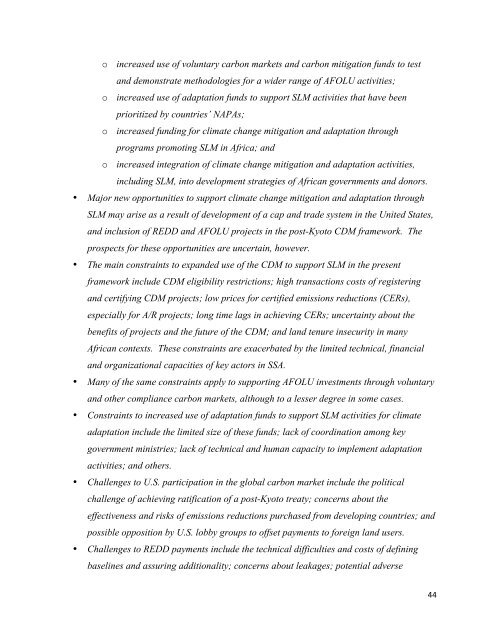The Role of Sustainable Land Management for Climate ... - CAADP
The Role of Sustainable Land Management for Climate ... - CAADP
The Role of Sustainable Land Management for Climate ... - CAADP
You also want an ePaper? Increase the reach of your titles
YUMPU automatically turns print PDFs into web optimized ePapers that Google loves.
!<br />
o increased use <strong>of</strong> voluntary carbon markets and carbon mitigation funds to test<br />
and demonstrate methodologies <strong>for</strong> a wider range <strong>of</strong> AFOLU activities;<br />
o increased use <strong>of</strong> adaptation funds to support SLM activities that have been<br />
prioritized by countries’ NAPAs;<br />
o increased funding <strong>for</strong> climate change mitigation and adaptation through<br />
programs promoting SLM in Africa; and<br />
o increased integration <strong>of</strong> climate change mitigation and adaptation activities,<br />
including SLM, into development strategies <strong>of</strong> African governments and donors.<br />
• Major new opportunities to support climate change mitigation and adaptation through<br />
SLM may arise as a result <strong>of</strong> development <strong>of</strong> a cap and trade system in the United States,<br />
and inclusion <strong>of</strong> REDD and AFOLU projects in the post-Kyoto CDM framework. <strong>The</strong><br />
prospects <strong>for</strong> these opportunities are uncertain, however.<br />
• <strong>The</strong> main constraints to expanded use <strong>of</strong> the CDM to support SLM in the present<br />
framework include CDM eligibility restrictions; high transactions costs <strong>of</strong> registering<br />
and certifying CDM projects; low prices <strong>for</strong> certified emissions reductions (CERs),<br />
especially <strong>for</strong> A/R projects; long time lags in achieving CERs; uncertainty about the<br />
benefits <strong>of</strong> projects and the future <strong>of</strong> the CDM; and land tenure insecurity in many<br />
African contexts. <strong>The</strong>se constraints are exacerbated by the limited technical, financial<br />
and organizational capacities <strong>of</strong> key actors in SSA.<br />
• Many <strong>of</strong> the same constraints apply to supporting AFOLU investments through voluntary<br />
and other compliance carbon markets, although to a lesser degree in some cases.<br />
• Constraints to increased use <strong>of</strong> adaptation funds to support SLM activities <strong>for</strong> climate<br />
adaptation include the limited size <strong>of</strong> these funds; lack <strong>of</strong> coordination among key<br />
government ministries; lack <strong>of</strong> technical and human capacity to implement adaptation<br />
activities; and others.<br />
• Challenges to U.S. participation in the global carbon market include the political<br />
challenge <strong>of</strong> achieving ratification <strong>of</strong> a post-Kyoto treaty; concerns about the<br />
effectiveness and risks <strong>of</strong> emissions reductions purchased from developing countries; and<br />
possible opposition by U.S. lobby groups to <strong>of</strong>fset payments to <strong>for</strong>eign land users.<br />
• Challenges to REDD payments include the technical difficulties and costs <strong>of</strong> defining<br />
baselines and assuring additionality; concerns about leakages; potential adverse<br />
!<br />
''!

















